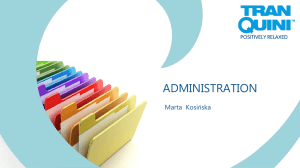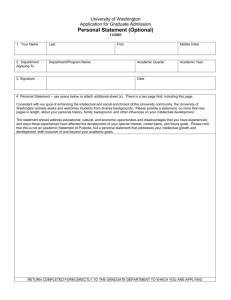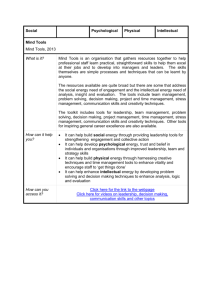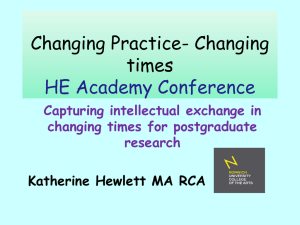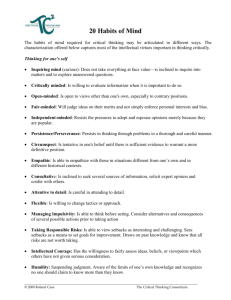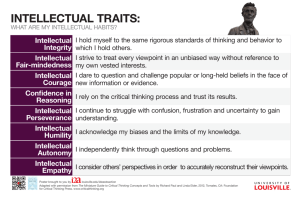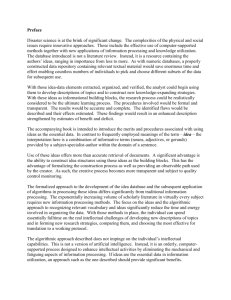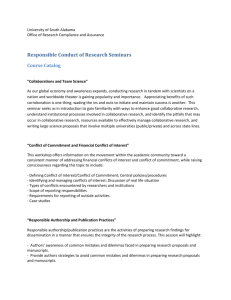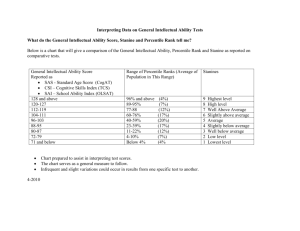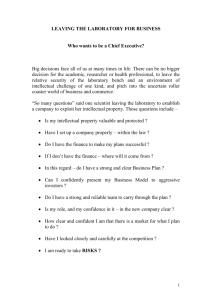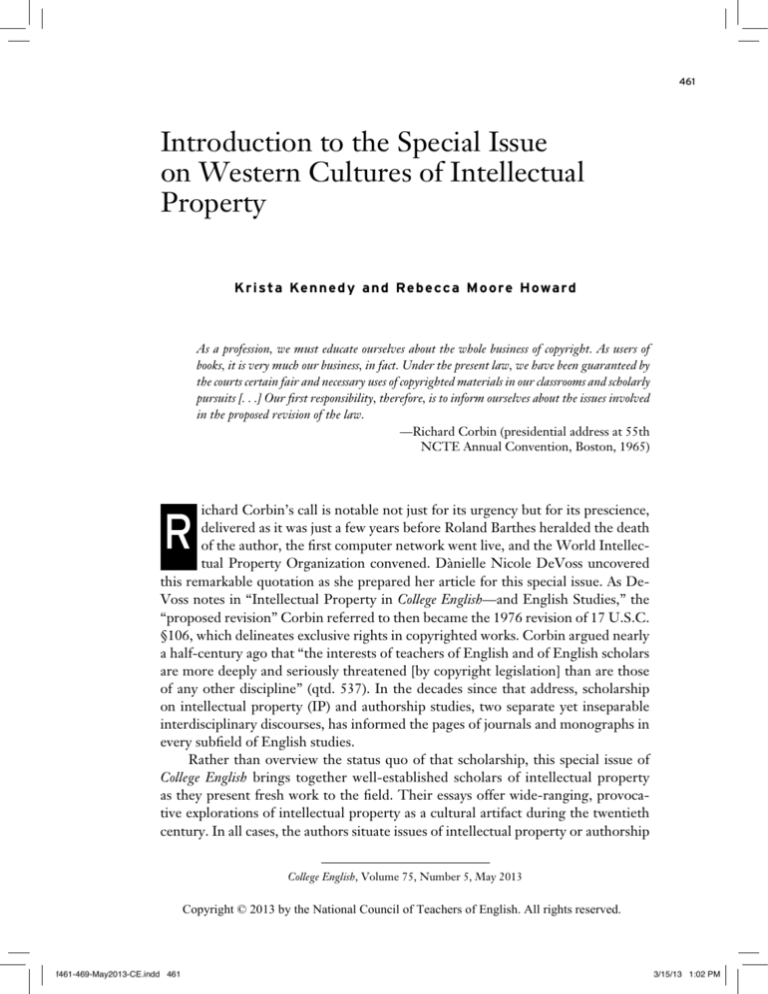
Introduction
461
Introduction to the Special Issue
on Western Cultures of Intellectual
Property
Krista Kennedy and Rebecca Moore Howard
As a profession, we must educate ourselves about the whole business of copyright. As users of
books, it is very much our business, in fact. Under the present law, we have been guaranteed by
the courts certain fair and necessary uses of copyrighted materials in our classrooms and scholarly
pursuits [. . .] Our first responsibility, therefore, is to inform ourselves about the issues involved
in the proposed revision of the law.
—Richard Corbin (presidential address at 55th
NCTE Annual Convention, Boston, 1965)
ichard Corbin’s call is notable not just for its urgency but for its prescience,
delivered as it was just a few years before Roland Barthes heralded the death
of the author, the first computer network went live, and the World Intellectual Property Organization convened. Dànielle Nicole DeVoss uncovered
this remarkable quotation as she prepared her article for this special issue. As DeVoss notes in “Intellectual Property in College English—and English Studies,” the
“proposed revision” Corbin referred to then became the 1976 revision of 17 U.S.C.
§106, which delineates exclusive rights in copyrighted works. Corbin argued nearly
a half-century ago that “the interests of teachers of English and of English scholars
are more deeply and seriously threatened [by copyright legislation] than are those
of any other discipline” (qtd. 537). In the decades since that address, scholarship
on intellectual property (IP) and authorship studies, two separate yet inseparable
interdisciplinary discourses, has informed the pages of journals and monographs in
every subfield of English studies.
Rather than overview the status quo of that scholarship, this special issue of
College English brings together well-established scholars of intellectual property
as they present fresh work to the field. Their essays offer wide-ranging, provocative explorations of intellectual property as a cultural artifact during the twentieth
century. In all cases, the authors situate issues of intellectual property or authorship
R
College English, Volume 75, Number 5, May 2013
Copyright © 2013 by the National Council of Teachers of English. All rights reserved.
f461-469-May2013-CE.indd 461
3/15/13 1:02 PM
462
College English
within not just an era, but a place or space: the mid-twentieth-century international
art community, the campus of a major private research university in the first decade
of the twenty-first century, the current social media landscape, and seventy-five
years of intellectual property discussions in this very journal. Thus, following
Rosemary Coombe, we describe this collection as addressing cultures of intellectual
property, and, in particular, Western cultures. This is not to exclude international
and transnational cultures of intellectual property; the works of scholars such as
Boatema Boateng, who investigates the cultural complexities of the “ownership” of
Kente cloth, are vital to scholars of intellectual property everywhere. In this issue,
though, we focus on Western cultures of intellectual property as a way of showing
just how much is at stake in many venues of what may seem a very contained frame.
We also wish to demonstrate the range of open—and emerging—questions within
that contained frame.
As we editors and contributors developed the shape and focus of this special
issue, we returned again and again to questions of context, pondering the ways in
which the confluence of cultures, eras, mediums, and technologies drive shifting understandings of the ways intellectual work can or should be owned. Related questions
concerning the labor of authors and the natural rights this labor might accord them
have resulted in vigorous debate in Western cultures, not just since the advent of the
Internet, but since the days of ancient Greece (Behme; Long) and Rome (Logie, “I
Have”), as well as seventeenth- and eighteenth-century England (Kennedy; Rose;
St. Clair). Much like the all-too-familiar shifts in the cultural value of professorial
labor during the intervening centuries, understandings of what this creature we
call an Author might be, the agency accorded her, and the value of a writer’s sweat
have also shifted. The idea that writers might be entitled to own their own texts by
dint of the labor invested is a relatively new idea, one that diverged from models of
organic, totalizing ownership by communities, religious organizations, patrons, and
publishers. These negotiations continue today, with slightly different factors in play:
most recently, many cultures have struggled with rebalancing understandings of the
value of knowledge work within the context of the information age.
Much of the intellectual property work in English studies has proceeded from
an interest in the cultural construction of authorship. Many readers of this special
issue of CE will already be familiar with Michel Foucault’s and Barthes’s rejoinders
to Romantic notions of an autonomous, unified, controlling Author. Their key works
have circulated in English studies for decades, fueled by post-structural skepticism
about the nature of text and textual production. In the early 1990s, for example,
Susan Stewart traced the relationship between originality and ownership; Marilyn
Randall, the impossibility of sustaining a belief in originality in the face of postmodern representations of subjectivity; and Françoise Meltzer, the consequences of
f461-469-May2013-CE.indd 462
3/15/13 1:02 PM
Introduction
463
the Romantic Author for female writers such as Colette. Perhaps best known from
the early 1990s is the work of Martha Woodmansee, often collaborating with legal
scholar Peter Jaszi. Woodmansee’s core interest, evidenced in The Author, Art, and
the Market, is in the underlying operation of economic capital in notions of authorship in eighteenth-century literature and aesthetics. With Jaszi, Woodmansee also
coedited an important collection, The Construction of Authorship. That collection
brought together a wide range of analyses addressing legal, theoretical, and cultural
issues in authorship, and it continues to be cited widely in contemporary scholarship. Woodmansee and Jaszi also collaborated on an article published in CE. As with
their other works, “The Law of Texts” articulated and organized a discourse that has
since occupied an ever-more-central place in English studies: the tension between
fair use and proprietors’ rights. Woodmansee and Jaszi ground their analysis in both
the established terms of authorship studies and the emerging urgency of legal issues.
They describe new laws that extend the term of copyright and decrease the amount
of texts available in the public domain, skewing the balance in favor of proprietors.
“Our object here,” they say, “is to alert readers to this development and call attention to its source in the general subjection of intellectual property law to a Romantic
aesthetic that is no longer current in literary and composition studies” (773). Their
most recent collection, coauthored with Mario Biagioli, highlights cultural perspectives on intersections of material production with intellectual property law and policy.
Technology shifts and their central role in these changes have drawn intensive
attention, sometimes to the extent that technologies are themselves accorded agency
by some scholars. Differing perspectives abound, and the chosen terminology marks
the conversation not just with ethos and emphasis, but with the mores of our era and
culture. Scholars from diverse fields agree that technology is not a neutral cultural
force driving human history, but rather a situated, integrated part of human life
(Pacey; Heilbroner; Licklider and Taylor; Smith). These assumptions inform many
conversations about technologies of literacy and are perhaps best evidenced in the
debate between Elizabeth Eisenstein, author of a landmark two-volume study of the
printing press, and Adrian Johns, who presents strong opposition to Eisenstein’s
positioning of the press as an agent of change. In this special issue, Jessica Reyman’s study of user data in social media demonstrates ways in which the notion of
an agentive technology can rob Internet users of privacy and even authorial rights.
Our contemporary experience of dramatic changes in the production and circulation of written text is co-occurring with lively debates among scholars, jurists,
educators, and journalists about the nature of authorship, publication, intellectual
property, and text itself. Much of this discourse is occurring outside English studies,
particularly in the rich field of legal studies (Boyle; Burk; Cohen; Litman; Patry). The
arguments of attorney Lawrence Lessig circulate widely in the academy, as Lessig
f461-469-May2013-CE.indd 463
3/15/13 1:02 PM
464
College English
argues against the ever-tightening corporate-and-government control of intellectual
properties, from popular music to literature. As Lessig, Siva Vaidhyanathan, and
other scholars have argued, prior intellectual property doctrine based on physical
property law is not completely transferable to digital spaces. The Internet, Lessig
asserts, should “force us to rethink the conditions under which the law of copyright
automatically applies, because it is clear that the current reach of copyright was
never contemplated, much less chosen, by the legislators who enacted copyright law”
(140). Instead of reimagining the laws to comport with the new technologies, these
scholars argue, governments backed by corporate interests strive to sustain printbased principles in a digital world and limit applications of fair use doctrine. Patricia
Aufderheide and Jaszi’s recent book Reclaiming Fair Use maps recent challenges to fair
use doctrine as well as best practices for using and preserving these essential rights.
Copyright subcultures are also influencing the dominant discourse on intellectual property. Creative Commons, the alternative copyright licensing system
developed by the Berkman Center for Internet and Society at Harvard, is now more
than a decade old. Internet communities and subcultures devoted to open-source and
open-access philosophies have matured in the past few years. Additionally, the loose
piratical communities that began decades ago on Usenet have now coalesced further
in communities such as Pirate Bay and Bibliotik. The tensions between sharing and
piracy, open and closed information, have resulted in a growing body of literature on
the commons (Benkler; Biagioli, Jaszi, and Woodmansee; Boyle; Hyde) and piracy
as a cultural artifact and practice (Biagioli, Jaszi, and Woodmansee; Johns, Piracy;
Logie, Peers, Piracy and Persuasion; Reyman). Conversations concerning open-source
software applications (DiBona, Ockman, and Stone, Open Sources; DiBona, Stone,
and Cooper, Open Sources 2.0; Raymond; Weber) and open-access publishing (Fitzpatrick; Willinsky) have also focused on the ramifications of sharing information
and technologies both inside the academy and in the larger information economy.
This special issue of CE is indebted to this and much more work in authorship
and intellectual property. The rich scholarship of English studies in the subfields
of authorship and IP cannot be done justice here, but the examples just provided
will, we hope, suggest some of that range and provide some context for the articles
in this special issue.
One of the distinctive contributions made by English studies to the scholarship
of intellectual property is a more thoughtful, even-handed examination of the relationship between students and IP. In this issue, Andrea Lunsford, Jenn Fishman, and
Warren Liew offer the perspectives of students themselves about issues of IP, and
they show how students’ notions of IP may develop over their college careers, and
beyond. Their article, which offers new data from the Stanford Study of Writing,
draws on student interviews in order to contextualize the historical marginalization
of student writing. Students, the authors note, may themselves have internalized and
f461-469-May2013-CE.indd 464
3/15/13 1:02 PM
Introduction
465
naturalized this marginalization, attributing little or no value to their own writing.
Yet when asked about the relation of IP to their writing, “even students who initially
insisted they were not informed about IP had something to say” (474). Intellectual
property matters to every writer—even those who have been taught that their writing
has no value. Lunsford, Fishman, and Liew conclude their article with recommendations for classroom instruction. Those recommendations are framed within what we
might describe as an update to Corbin’s 1965 call for scholarly attention to intellectual
property: These researchers call for a student-centered, inquiry-based pedagogy of
IP (which we would contrast with the top-down admonitions against infringing on
others’ property that are usually the beginning and end of IP conversations between
faculty and students). “Devising assignments that bring students to early awareness
of IP economies can, we believe, better prepare them for the complex negotiations
they face both in school and out” (489).
John Logie turns our attention to the theoretical foundations of intellectual
property studies. Arguing for careful attention to cultural context, he takes up a
midcentury moment in the history of authorship and IP. Logie’s analysis of the
circumstances of the publication of Roland Barthes’s familiar essay “The Death of
the Author” entails a significant recontextualization of, and thus a new understanding of, that piece. Logie’s article, “1967: The Birth of ‘The Death of the Author,’”
puts Barthes’s ideas on authorship in tension with the contemporary expansion of
copyright. Although Barthes’s essay does indeed treat the status of the Author, it is
a 1967 essay (rather than the oft-attributed 1968), and it was first published in the
United States, in English, as an antifoundationalist artistic manifesto in Aspen, the
“magazine in a box,” rather than as the journal article that it became when it was
republished in French in 1968. The difference, Logie argues, is substantial: taken
in the context of its initial publication, “The Death” is less political and more about
multimedia than readers of Barthes’s essay collection Image-Music-Text might otherwise realize. The familiar contextualization of “The Death” in the May 1968 Parisian
student uprisings is, Logie explains, simply wrong. Our most basic understandings of
Western authorship and intellectual property, drawn from foundational documents,
shift when we consider the cultural context in which this foundational document
was published—and for which it was written. “The Death” is not a freestanding essay
for which Barthes “found” a publisher; it is an essay invited for and published in a
multimedia art collection, a ’60s “happening.” Its attention to the work of Stéphane
Mallarmé may derive as much from the focus of Aspen 5+6, which was dedicated to
Mallarmé, as from Barthes’s own interests. “The challenge we now face,” says Logie,
“is one of unteaching ‘The Death of the Author’ as a literary essay and of re-teaching
it as a participant in a collection of artistic manifestos and provocations” (510).
Reyman offers a surprising, unfamiliar perspective on intellectual property when
she explores the unintentional compositions that participants in social media services
f461-469-May2013-CE.indd 465
3/15/13 1:02 PM
466
College English
create: the data they contribute to these services that is then mined for commercial
purposes. “User Data on the Social Web: Authorship, Agency, and Appropriation”
pushes us toward a new conception of authorship, as Reyman acknowledges that
even in our unintentional authoring as we push the “Like” button on Facebook or
upload pictures from our vacation, we are exerting agency in the creation of a new,
albeit often invisible, text. She explains, “User data [. . .] is not merely a technology
by-product to be bought and sold; rather, it forms a dynamic, discursive narrative
about the paths we have taken as users, the technologies we have used, how we have
composed in such spaces, and with whom we have participated” (516). User data is,
however, a form of authorship over which users have little control and of which they
may have little awareness and no ownership, notwithstanding their demonstrated
agency in creating the data.
Reyman undertakes a case study of Facebook’s terms of service and the successive protests to its increasing incursions into users’ privacy. Social media actually
leaves users only the binary choice of complying or exiting, given that reading all
terms-of-service policies for all sites visited would consume seventy-six of each user’s
workdays annually. The solution, Reyman says, is not to avoid Internet use or to try
to withhold personal information, but to “reconceptualize user data as dynamic, living
texts rather than as technology by-products to be bought and sold” (523). If we cease
to allow the currently prevailing distinction between “user content” and “user data,”
we can assert IP rights over all our online activities. This prospect is muddied by
copyright law’s coverage of expression but not facts; isn’t user data a “fact”? Reyman’s
reply argues for an inextricable relationship between user content and user data; the
two cannot be logically divided. Terms-of-service documents cast Internet users in
a passive role, with technology the active agent as it mines user data and deploys it
for commercial purposes. Readers of CE will no doubt hear echoes of the calls for
a balance between users’ rights and authors’ rights when Reyman declares, “The
practices of generating, aggregating, and interpreting user data could be understood
as collaborative, authorial acts of technological and human agency. With a balancing
of users’ and technology companies’ rights over user data, the social and participatory web could be nourished as a space that provides access to tools for participation
and production, and also recognizes the value of human agency required for rich,
meaningful social networks” (528). Her essay concludes with recommendations for
ways in which users could participate in the development of such rights.
DeVoss concludes this issue by providing a historical perspective on our field’s
attention to intellectual property. She offers a very particular sort of review essay:
“Intellectual Property in College English—and English Studies” reviews how IP has
been discussed in and elided from the pages of CE from its 1939 first issue through
the present. DeVoss’s result is enlightening and sometimes startling. Readers of
this issue of CE may be interested to know that even in 1943, before the Recording
f461-469-May2013-CE.indd 466
3/15/13 1:02 PM
Introduction
467
Industry Association of America (RIAA) and before “The Death of the Author,” the
journal was publishing nuanced analyses of literary piracy; in 1962 instructors were
sensitive to the cost of textbooks and the issue of fair use; and in 1966 scholars feared
the death of the book. DeVoss identifies Corbin’s 1965 NCTE address, published
the next year in CE, as a central document in the history of intellectual property
scholarship in English studies, because he charted NCTE’s participation in the
development of the 1976 US Copyright Law and urged English scholars to inform
themselves about and involve themselves in intellectual property issues. Post-1994,
DeVoss finds that IP scholarship in CE “emerged as itself a core topic and core focus of research, scholarship, and debate” (540), with Woodmansee and Jaszi’s 1995
“The Law of Texts” a “landmark article” (541). DeVoss also identifies six threads
of IP scholarship in CE that ably capture the work published elsewhere in English
studies. She concludes her article—and, appropriately, this issue—by synthesizing
recommendations for scholars and teachers from the essays she has surveyed. It is
our hope, as editors of this set of articles, that readers will be challenged to consider
the ways in which the complexities of intellectual property thread through all the
work we do in the field of English studies.
Works Cited
Aufderheide, Patricia, and Peter Jaszi. Reclaiming Fair Use: How to Put Balance Back in Copyright. Chicago:
U of Chicago P, 2011. Print.
Barthes, Roland. “The Death of the Author.” Aspen: The Magazine in a Box 5+6. ubu.com. UbuWeb, 1967.
Web. 20 Nov. 2012. <http://www.ubu.com/aspen/aspen5and6/index.html>.
Behme, Tim. “Isocrates on the Ethics of Authorship.” Rhetoric Review 23.3 (2004), 197–215. Print.
Benkler, Yochai. The Wealth of Networks: How Social Production Transforms Markets and Freedom. New
Haven: Yale UP, 2007. Print.
Biagioli, Mario, Peter Jaszi, and Martha Woodmansee, eds. Making and Unmaking Intellectual Property:
Creative Production in Legal and Cultural Perspective. Chicago: U of Chicago P, 2011. Print.
Boateng, Boatema. The Copyright Thing Doesn’t Work Here: Adinkra and Kente Cloth and Intellectual Property
in Ghana. Minneapolis: U Minnesota P, 2011. Print.
Boyle, James. The Public Domain: Enclosing the Commons of the Mind. New Haven: Yale UP, 2010. Print.
Burk, Dan. “Materiality and Textuality in Digital Rights Management.” Computers and Composition 27.3
(Sept. 2010), 225–34. Print.
Cohen, Julie E. Configuring the Networked Self: Law, Code, and the Play of Everyday Practice. New Haven:
Yale UP, 2012. Print.
Coombe, Rosemary. The Cultural Life of Intellectual Properties: Authorship, Appropriation, and the Law.
Durham: Duke UP, 1998. Print.
DiBona, Chris, Sam Ockman, and Mark Stone, eds. Open Sources: Voices from the Open Source Revolution.
Sebastopol: O’Reilly, 1999. Print.
DiBona, Chris, Mark Stone, and Danese Cooper, eds. Open Sources 2.0: The Continuing Evolution. Sebastopol: O’Reilly, 2005. Print.
Eisenstein, Elizabeth. The Printing Press as an Agent of Change. 2 vols. Cambridge: Cambridge UP,
1979–80. Print.
f461-469-May2013-CE.indd 467
3/15/13 1:02 PM
468
College English
Fitzpatrick, Kathleen. Planned Obsolescence: Publishing, Technology, and the Future of the Academy. New
York: NYU Press, 2011. Print.
Foucault, Michel. “What Is an Author?” Bulletin de la Société française de philosophie 63.3 (1969): 73–104.
Rpt. Language, Counter-Memory, Practice: Selected Essays and Interviews. Ed. Donald F. Bouchard.
Trans. Donald F. Bouchard and Sherry Simon. Ithaca: Cornell UP, 1977. 113–38. Print.
Heilbroner, Robert L. “Do Machines Make History?” Does Technology Drive History? The Dilemma of Technological Determinism. Ed. Merritt Roe Smith and Leo Marx. Cambridge: MIT P, 1994. 37–66. Print.
Hyde, Lewis. Common as Air: Revolution, Art, and Ownership. New York: Farrar, Straus and Giroux:
2010. Print.
Johns, Adrian. The Nature of the Book: Print and Knowledge in the Making. Chicago: U of Chicago P, 2000.
Print.
———. Piracy: The Intellectual Property Wars from Gutenberg to Gates. Chicago: U of Chicago P, 2009. Print.
Kennedy, Krista. “The Daw and the Honeybee: Situating Metaphors for Originality and Authorial Labor
in the 1728 Chambers’ Cyclopædia.” College English, forthcoming September 2013. Print.
Lessig, Lawrence. Free Culture: How Big Media Uses Technology and the Law to Lock Down Culture and
Control Creativity. New York: Penguin Press, 2004. Print.
Licklider, J. C. R., and Robert W. Taylor. “The Computer as a Communication Device.” Science and
Technology (1968): 12–31. Print.
Litman, Jessica. Digital Copyright. Amherst: Prometheus Books, 2006. Print.
Logie, John. “‘I Have No Predecessor to Guide My Steps’: Quintilian and Roman Authorship.” Rhetoric
Review 22.4 (2003): 353–73. Print.
———. Peers, Pirates, and Persuasion: Rhetoric in the Peer-to-Peer Debates. Parlor Press: 2006. Print.
Long, Pamela. Openness, Secrecy, Authorship: Technical Arts and the Culture of Knowledge from Antiquity to
the Renaissance. Baltimore: Johns Hopkins UP, 2001. Print.
Meltzer, Françoise. Hot Property: The Stakes and Claims of Literary Originality. U of Chicago P, 1994. Print.
Pacey, Arnold. The Culture of Technology. Cambridge: MIT P, 1983. Print.
Patry, William. Moral Panics and the Copyright Wars. New York: Oxford UP, 2009. Print.
Randall, Marilyn. “Appropriate(d) Discourse: Plagiarism and Decolonization.” New Literary History 22.3
(1991): 525–41. Print.
Raymond, Eric. The Cathedral and the Bazaar: Musings on Linux and Open Source by an Accidental Revolutionary. Sebastopol: O’Reilly Media, 1999. Print.
Reyman, Jessica. The Rhetoric of Intellectual Property: Copyright Law and the Regulation of Digital Culture.
New York: Routledge, 2009. Print.
Rose, Mark. Authors and Owners: The Invention of Copyright. Cambridge: Harvard UP: 1995. Print.
Smith, Merritt Roe. “Technological Determinism in American Culture.” Does Technology Drive History?
The Dilemma of Technological Determinism. Ed. Merritt Roe Smith and Leo Marx. Cambridge: MIT
P, 1994. 1–36. Print.
Smith, Merritt Roe, and Leo Marx, eds. Does Technology Drive History? The Dilemma of Technological
Determinism. Cambridge: MIT P, 1994. Print.
St. Clair, William. “Metaphors of Intellectual Property.” Privilege and Property: Essays on the History of
Copyright. Ed. Ronan Deazley, Martin Kretschmer, and Lionel Bentley. Cambridge: OpenBook
Press, 2010. 369–95. Print.
Stewart, Susan. Crimes of Writing: Problems in the Containment of Representation. New York: Oxford UP,
1991. Print.
Vaidhyanathan, Siva. Copyrights and Copywrongs: The Rise of Intellectual Property and How It Threatens
Creativity. New York: New York UP, 2003. Print.
f461-469-May2013-CE.indd 468
3/15/13 1:02 PM
Introduction
469
Weber, Steven. The Success of Open Source. Cambridge: Harvard UP, 2005. Print.
Willinsky, John. The Access Principle: The Case for Open Access to Research and Scholarship. Cambridge: MIT
P, 2009. Print.
Woodmansee, Martha. The Author, Art, and the Market: Rereading the History of Aesthetics. New York:
Columbia UP, 1994. Print.
Woodmansee, Martha, and Peter Jaszi, eds. The Construction of Authorship: Textual Appropriation in Law
and Literature. Durham: Duke UP, 1994. Print.
———. “The Law of Texts: Copyright in the Academy.” College English 57.7 (1995): 769–87. Print.
f461-469-May2013-CE.indd 469
3/15/13 1:02 PM
L551-552-May2013-CE.indd 551
3/15/13 1:02 PM
DO NOT PRINT [publication: College English [NCTE] (May 2013) — placement: Facing Cover 3 — ad size: 5 x 7.625]
what’s possible | bedfordstmartins.com
Handbooks that work
With a Bedford / St. Martin’s handbook, students can quickly find reliable writing and
research information on their own. All Bedford handbooks are now available as ebooks at a significant savings. Most are available with LearningCurve, adaptive online
quizzing that focuses students on the topics they need to practice — free when packaged with the book. Visit bedfordstmartins.com/handbooks.
TABB
VERS ED
ION
AL
AVAILSO
ABLE
NEW
EXER
C
VERS ISE
IO
ALS N
AVAIL O
ABLE
ONL
HAND INE
BOOK
NEW AP
A
VERSIO
N
AVAILA
BLE
!
NEW
MULTIM
ODA
VERSIO L
N
AVAILA
BLE!
writershelp.com
L551-552-May2013-CE.indd 552
3/15/13 1:02 PM

